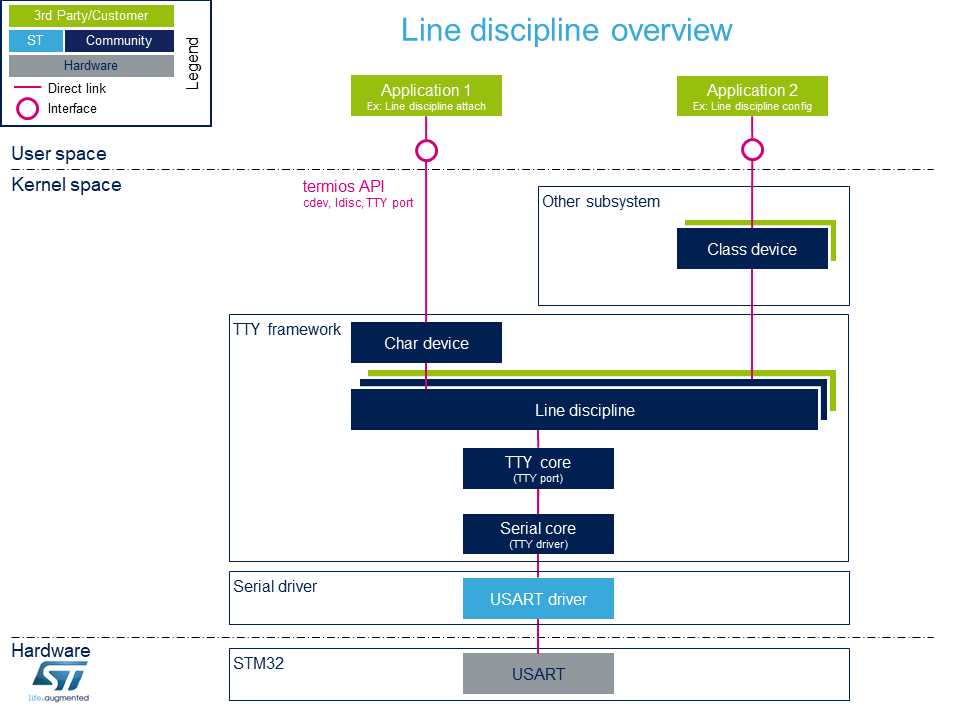“Serial TTY line discipline”的版本间的差异
| 第2行: | 第2行: | ||
==Framework purpose== | ==Framework purpose== | ||
| − | + | UART是几种设备类型(例如蓝牙,NFC,FM收音机和GPS设备)的通用接口。 <br/> | |
| − | + | 从内核版本4.12开始,TTY框架中引入了串行设备总线(也称为Serdev),以改善提供给连接到串行端口的设备的接口。 请参考 [[Serial TTY overview]]文章,以详细了解TTY框架的用途。尽管如此,仍然有可能(即使不推荐)使用行规“驱动程序”。 | |
| − | + | 本文重点介绍提供给连接到串行端口的设备的线路规范接口。 | |
| − | + | ||
==System overview== | ==System overview== | ||
[[File:Serial TTY Line Discipline overview.png|center|link=]] | [[File:Serial TTY Line Discipline overview.png|center|link=]] | ||
2020年11月9日 (一) 10:42的版本
本文提供有关 Linux® TTY 框架的信息。 它说明了如何使用线路规则激活“ UART”接口,以及如何从用户和内核空间访问它。
目录
Framework purpose
UART是几种设备类型(例如蓝牙,NFC,FM收音机和GPS设备)的通用接口。
从内核版本4.12开始,TTY框架中引入了串行设备总线(也称为Serdev),以改善提供给连接到串行端口的设备的接口。 请参考 Serial TTY overview文章,以详细了解TTY框架的用途。尽管如此,仍然有可能(即使不推荐)使用行规“驱动程序”。
本文重点介绍提供给连接到串行端口的设备的线路规范接口。
System overview

Components description
From client application to hardware
- Application: customer application to read/write data from the peripheral connected on the serial port.
- TTY tools: tools provided by Linux community, such as stty, ldattach, inputattach, tty, ttys, agetty, mingetty, kermit and minicom.
<securetransclude src="ProtectedTemplate:ReviewsComments" params="FGA W1941: I can't find TTY tools in above figure. Is it relevant here?."></securetransclude>{{#set:Has reviews comments=true}}
- Termios: API[1] which offers an interface to develop an application using serial drivers.
- Client subsystem: kernel subsystem client of TTY core (Example: a Bluetooth device)
<securetransclude src="ProtectedTemplate:ReviewsComments" params="FGA W1941: I can't find "Client subsystem" in above figure."></securetransclude>{{#set:Has reviews comments=true}}
- TTY framework: high-level TTY structures management, including drivers/tty/tty_io.c | |}} tty character device driver , drivers/tty | |}} TTY core functions , line discipline.
<securetransclude src="ProtectedTemplate:ReviewsComments" params="FGA W1941: "TTY framework" -> "TTY Core" in above figure ?"></securetransclude>{{#set:Has reviews comments=true}}
- Serial framework: low-level serial driver management, including the drivers/tty/serial/serial_core.c | |}} serial core functions .
<securetransclude src="ProtectedTemplate:ReviewsComments" params="FGA W1941: "Serial framework" -> "Serial Core" in above figure ?"></securetransclude>{{#set:Has reviews comments=true}}
- USART driver: drivers/tty/serial/stm32-usart.c | |}} stm32-usart low-level serial driver for all stm32 family devices.
- STM32 USART: STM32 frontend IP connected to the external devices through a serial port
<securetransclude src="ProtectedTemplate:ReviewsComments" params="FGA W1941: Maybe worth adding the external device in the above figure ?"></securetransclude>{{#set:Has reviews comments=true}}
APIs description
The TTY provides only character device interface (named /dev/ttyX) to user space.
The main API for user space TTY client applications is provided by the portable POSIX terminal interface termios, which relies on /dev/ttyX interface for TTY link configuration.
The termios API[1] is a user land API, and its functions describe a general terminal interface that is provided to control asynchronous communications ports.
The POSIX termios API abstracts the low-level details of the hardware, and provides a simple yet complete programming interface that can be used for advanced projects. It is a wrapper on character device API [2] ioctl operations.
| A line discipline driver can be used when a serial interface is needed at kernel level. |
For example, a kernel driver maybe needed to control an external device through an U(S)ART port. <securetransclude src="ProtectedTemplate:ReviewsComments" params="FGA W1941: I rephrased above note, can you please double-ckeck ?"></securetransclude>{{#set:Has reviews comments=true}}
- The line discipline will be responsible for:
- creating this new kernel API
- routing data flow between serial core and new kernel API
<securetransclude src="ProtectedTemplate:ReviewsComments" params="FGA W1941: No how to use section, nor examples ? Is it deliberate ?<br/> FGA W1941: Maybe worth pointing out some existing examples in the kernel ?"></securetransclude>{{#set:Has reviews comments=true}}
References
- ↑ 1.01.1 termios API, Linux Programmer's Manual termios API Documentation (user land API with serial devices)
- ↑ Character device API overview, Accessing hardware from userspace training, Bootlin documentation